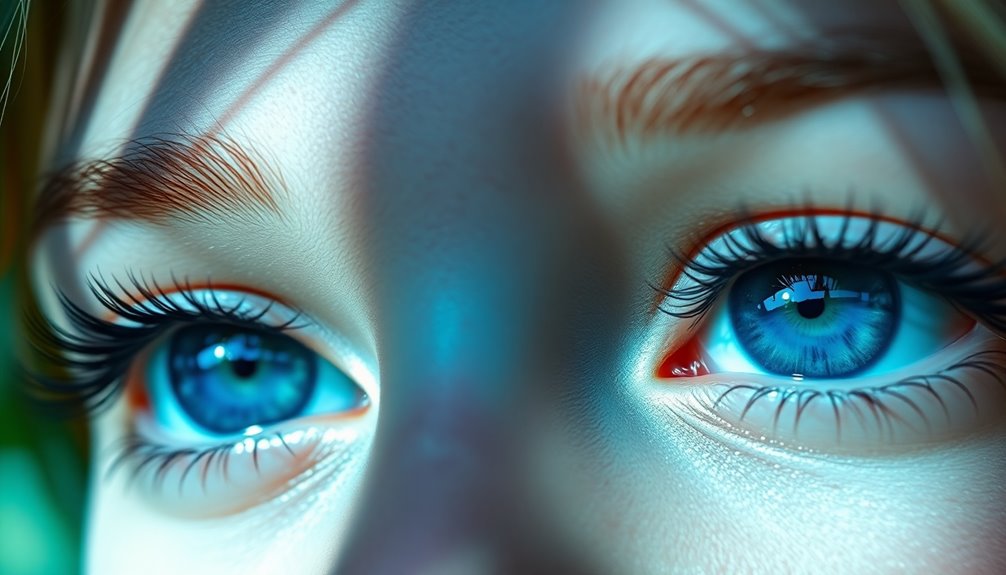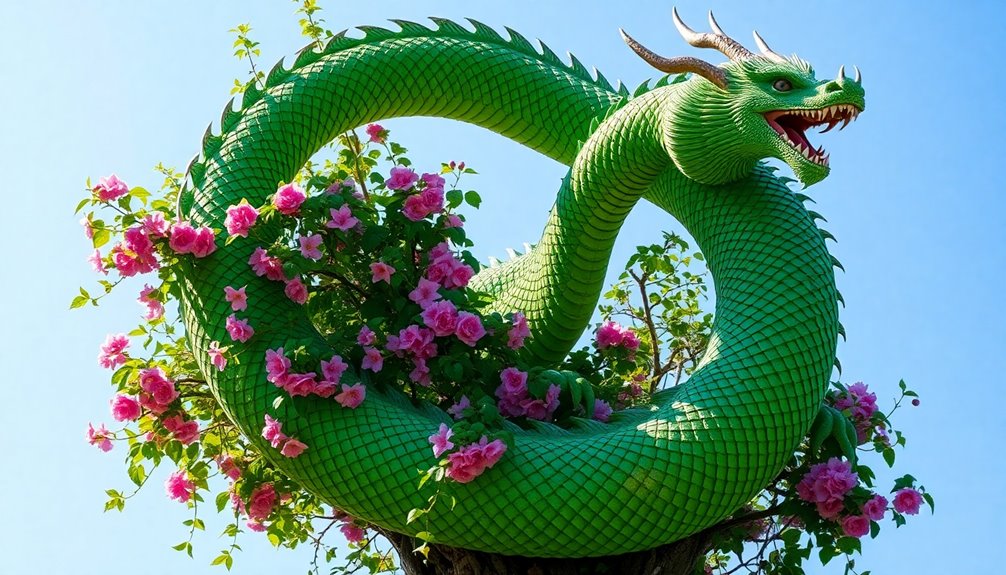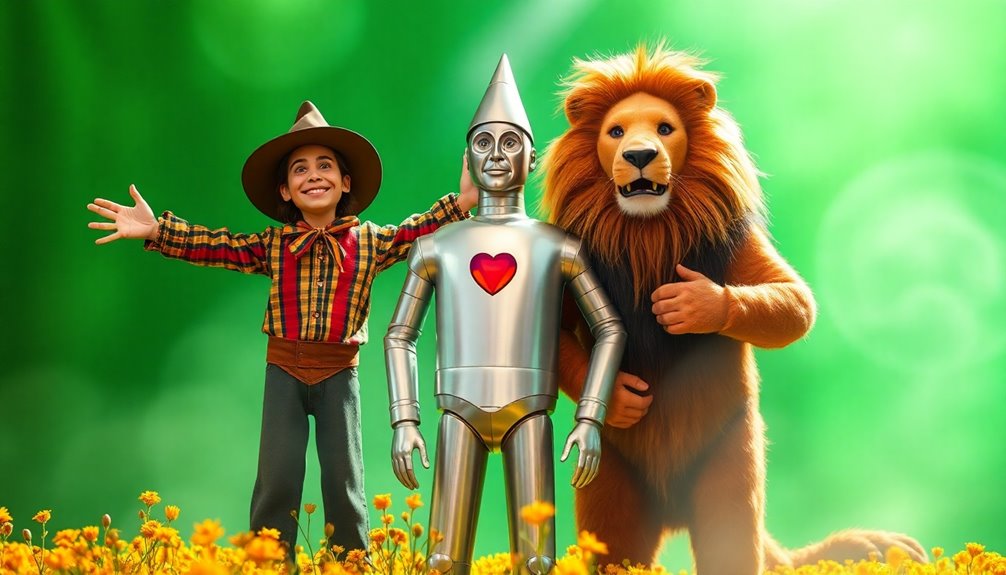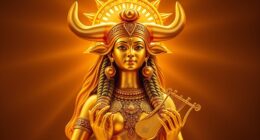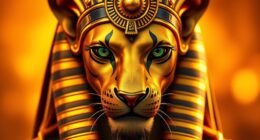Blue eyes symbolize tranquility and clarity, drawing you in with their calming presence. This azure gaze inspires trust, fostering deeper emotional connections. They're linked to the throat chakra, encouraging open communication and truthfulness. Culturally, blue eyes have represented divine favor in ancient Egypt and caution in Greek mythology. Their unique beauty captivates, creating an enchanting allure that sparks curiosity about the individuals behind them. When you look into blue eyes, you might feel a sense of peace and understanding. There's more to uncover about the rich symbolism and emotional power of blue eyes—so don't stop here!
Key Takeaways
- Blue eyes symbolize tranquility and calmness, evoking a sense of peace and emotional clarity in interactions.
- They are associated with open communication, enhancing trust and fostering deeper emotional connections.
- The ethereal quality of blue eyes creates an allure that draws curiosity and admiration from others.
- Cultural interpretations link blue eyes to divine favor, protection, and spiritual enlightenment, enriching their symbolism.
- Eye contact with blue-eyed individuals promotes effective non-verbal communication, inviting empathy and understanding in relationships.
Symbolism of Blue Eyes
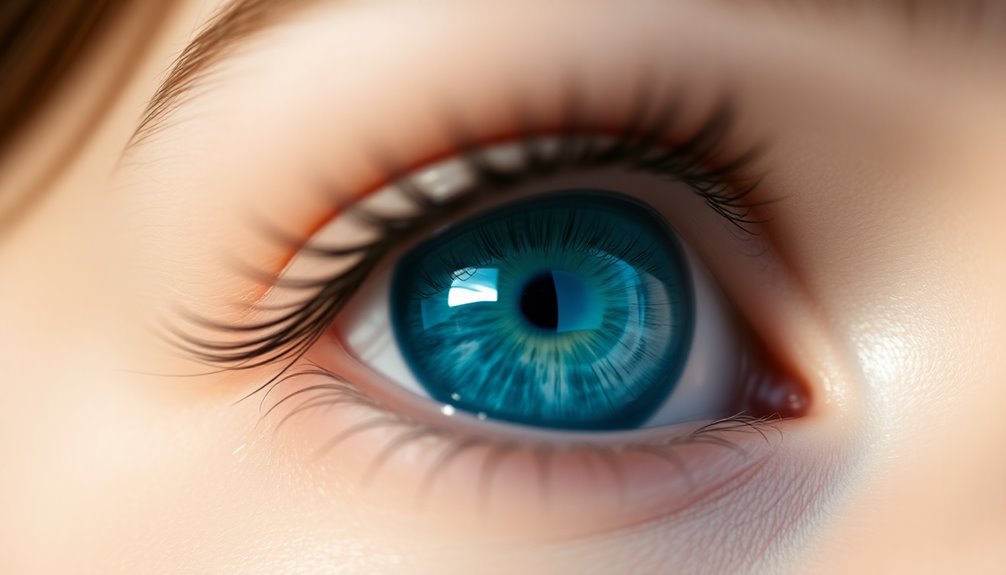
Blue eyes captivate and draw people in, often symbolizing tranquility and calmness. When you see someone with blue eyes, you might feel a sense of peace wash over you, as if their gaze can soothe your worries. The color blue is often linked to the throat chakra, promoting open communication and truth-telling. This connection may explain why blue-eyed individuals often inspire trust and reliability in others, fostering deeper interpersonal connections.
In various cultures, blue eyes are seen as a representation of clarity and insight. You might find that people with blue eyes have a unique ability to perceive deeper truths, making their perspectives valuable in conversations. Their rarity—occurring in just 8-10% of the global population—adds to the allure and symbolic significance of blue eyes.
This uniqueness not only enhances their beauty but also contributes to a sense of individuality. Ultimately, blue eyes embody a blend of serenity and depth, inviting you to explore the calmness they represent. Whether you have blue eyes or simply admire them, their symbolism resonates with the ideals of clarity, trust, and an innate connection to truth.
Emotional and Spiritual Connections

When you gaze into blue eyes, you often sense a deep inner peace and clarity that invites emotional understanding.
This tranquility can spark spiritual awakenings and insights, guiding you towards a greater awareness of yourself and others.
As you connect with the emotional depth found in these striking eyes, you may discover a profound bond that enhances your personal and interpersonal relationships.
Inner Peace and Clarity
The serene quality of blue eyes often evokes feelings of tranquility and calmness, creating a soothing presence for those who encounter them. When you look into blue eyes, you might sense a profound inner peace that resonates deeply within you, offering a moment of respite from the chaos of daily life.
This emotional clarity that blue eyes symbolize encourages you to connect with your true self and fosters understanding between you and others.
In many cultures, blue eyes are seen as a reflection of spiritual awareness, urging you to embrace authenticity in your interactions. When engaging with someone who's blue eyes, you may find that empathy flows more easily, enhancing your ability to communicate openly and honestly.
This connection can help you navigate complex emotions and strengthen your relationships.
Moreover, studies suggest that people with blue eyes are often perceived as more approachable and trustworthy. This perception can lead to deeper emotional bonds, allowing you to share your thoughts and feelings without fear of judgment.
Ultimately, the symbolism of blue eyes serves as a gentle reminder that inner peace and emotional clarity are essential for nurturing meaningful connections.
Spiritual Awakening and Insights
Through their enchanting hue, light blue eyes often symbolize wisdom and spiritual awakening, inviting you to explore a deeper connection with your higher consciousness. When you notice blue eyes, whether in others or in dreams, they may signal a call for healing and restoration in your life. This connection fosters your growth and enhances your intuition, guiding you toward the truths that lie within.
Blue eyes encourage you to embrace open communication and seek new perspectives. They promote honesty, allowing you to strengthen your interpersonal relationships while deepening your understanding of yourself and others. In many cultures, blue eyes are viewed as a sign of divine protection and guidance, reminding you of the spiritual insights available to you.
As you engage with the symbolism of blue eyes, you may find yourself drawn to a pursuit of clarity beyond illusions. This journey encourages deeper self-awareness, helping you navigate your spiritual awakening.
Ultimately, blue eyes serve as a gentle reminder that wisdom and authenticity are within your reach, illuminating your path toward a more profound understanding of life and your place in it.
Emotional Depth and Understanding
Blue eyes embody a profound emotional depth that resonates with your ability to connect and empathize with others. This emotional depth reflects your understanding of both your feelings and those of the people around you.
The calmness associated with blue eyes fosters tranquility, creating a peaceful atmosphere in your interactions. You're likely to notice that this clarity encourages open communication, allowing for honest expressions of thoughts and emotions that strengthen your relationships.
Moreover, individuals with blue eyes often exhibit enhanced intuitive abilities, akin to the Eye of Horus—a symbol of protection and insight. This connection to spiritual clarity enhances your understanding of deeper emotional currents, guiding you in moments of uncertainty.
As you navigate your relationships, seek authenticity; blue eyes urge you to pursue truth in both your emotions and those of others.
Cultural Interpretations of Blue Eyes
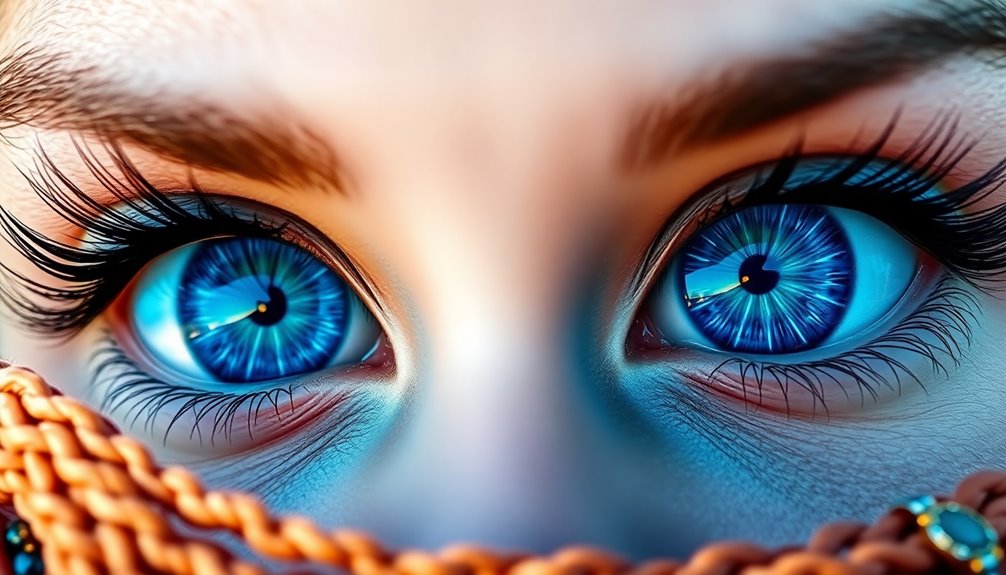
Many cultures around the world have imbued blue eyes with rich symbolism and unique interpretations. You might see blue eyes, often called "baby blues," depicted in art and literature as symbols of grace and allure, highlighting their rarity and beauty.
In ancient Egypt, blue eyes were considered signs of divine favor, linked to the Eye of Horus, which promised healing and protection.
Conversely, in Greek mythology, blue eyes held a more cautionary significance, as they were associated with the Evil Eye, a force believed to bring misfortune. Many Middle Eastern cultures embrace the Nazar Boncugu, a blue eye amulet intended to ward off negative energies and attract good fortune, showcasing the protective nature attributed to blue eyes.
In Buddhism, blue symbolizes spiritual enlightenment and wisdom, suggesting a deeper understanding of life's mysteries.
Whether viewed as "windows to the soul" or as a mark of divine favor, blue eyes resonate with various meanings. As a dream interpreter might suggest, your own experiences with blue eyes can influence how you perceive their cultural significance.
Ultimately, these interpretations reveal the profound impact that blue eyes have across different societies.
The Allure and Mystery
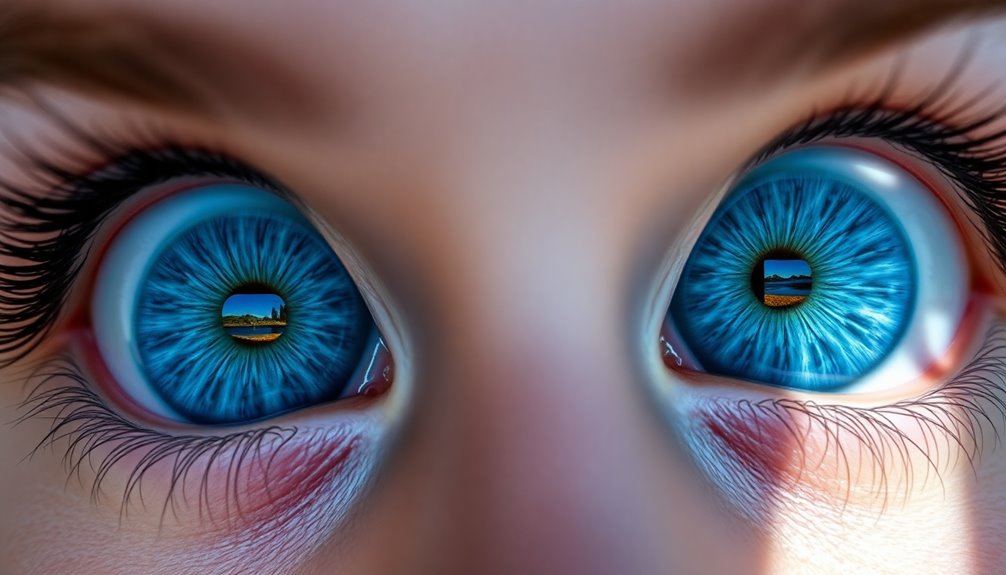
There's something undeniably enchanting about blue eyes that draws people in, creating an aura of mystery and allure. Their ethereal quality fascinates observers, making you wonder what secrets lie behind that striking azure hue. When you lock eyes with someone who possesses this mesmerizing color, it often feels like time stands still, forging a connection that's both profound and hypnotic.
Cultural perceptions frequently elevate blue eyes to symbols of beauty and charm, enhancing their allure in social interactions. You might notice how people gravitate toward individuals with blue eyes, driven by an innate curiosity. The depth of their gaze invites exploration and intrigue, prompting you to explore deeper into their world.
However, this fascinating gaze can evoke mixed feelings. While admiration flows freely, jealousy can simmer beneath the surface as others might envy the attention blue-eyed individuals command.
Ultimately, the allure and mystery of blue eyes create a unique dynamic, encouraging connections based on fascination and wonder. So, the next time you encounter those striking eyes, embrace the enchantment they bring, as they hold a world of intrigue waiting to be discovered.
Communication Through Eye Contact
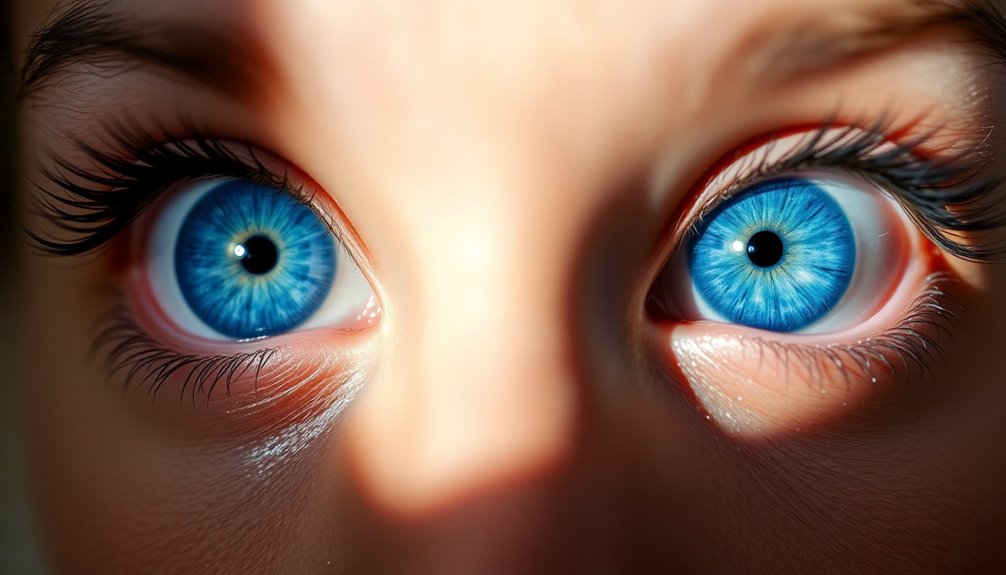
When you lock eyes with someone, especially if they've blue eyes, you're tapping into a powerful form of non-verbal communication.
This connection can express emotions and intentions without a single word, enhancing your interaction.
Non-Verbal Emotional Expression
Eye contact plays an essential role in non-verbal emotional expression, and blue eyes can intensify this connection. When you lock eyes with someone who's striking blue irises, you often feel a sense of calm and tranquility. This unique hue can facilitate peace in your interactions, allowing emotions and intentions to flow without the need for spoken words.
Research shows that eye color, particularly blue, influences how you perceive and engage with others. The depth of a blue gaze can evoke empathy, fostering a deeper emotional rapport in social settings. You might notice how the intensity of blue eyes enhances non-verbal cues, promoting immediate understanding between you and the other person.
This effect can create an intimate connection that draws you in, making it easier to share your feelings and thoughts. When you communicate through eye contact with blue-eyed individuals, you often feel more understood and connected.
Strengthening Interpersonal Connections
Connecting through eye contact can greatly enhance your interpersonal relationships, especially with someone who's striking blue eyes. When you lock eyes with someone, particularly those with azure gazes, you're engaging in a powerful form of non-verbal communication. This connection often conveys emotions and intentions without needing words, making conversations feel more meaningful.
Studies show that direct eye contact can considerably improve interpersonal interactions. It fosters a sense of understanding and connection, creating an inviting atmosphere. Blue eyes, in particular, are often perceived as trustworthy, which can strengthen your relationship and encourage open dialogue. This perception allows for more authentic exchanges, where both parties feel safe sharing their thoughts and feelings.
Additionally, the calming effect associated with blue eyes promotes a serene environment. This tranquility makes discussions relaxed and conducive to deeper connections. Engaging with someone who's these enchanting eyes can lead to an intoxicating experience, igniting emotional bonds and mutual recognition.
Personal Reflections and Insights
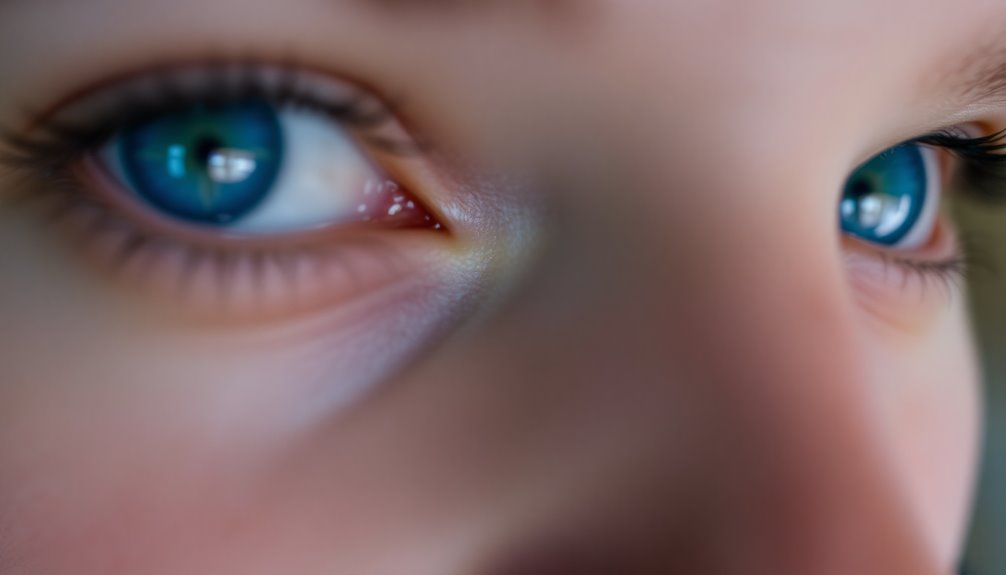
Gazing into the depths of blue eyes often stirs a sense of calm and tranquility within you, prompting introspection and self-awareness. The unique hues of blue can evoke feelings of peace, guiding you toward deeper reflections about your emotions and experiences.
You might find that those with blue eyes possess an emotional depth that resonates with your own feelings, creating a natural space for understanding and empathy.
When you reflect on blue eyes, consider the following:
- Emotional Clarity: The soothing qualities of blue can help clear your mind, allowing for more profound insights during self-reflection.
- Approachability: You may notice that individuals with blue eyes often come across as warm and honest, enhancing your willingness to connect.
- Empathy and Compassion: Being around blue-eyed individuals might inspire you to tap into your own capacity for empathy, deepening your connections with others.
In these moments of introspection, the azure gaze invites you to explore your inner world, fostering a greater understanding of yourself and your relationships.
Frequently Asked Questions
What Do Blue Eyes Symbolize Spiritually?
Blue eyes symbolize tranquility and peace in a spiritual sense, reflecting your deep emotional and spiritual connections. They often signify heightened intuition, helping you perceive deeper truths and insights.
The color blue represents authenticity, urging you to align with your inner self and pursue honesty in your communication. Additionally, blue eyes are linked to spiritual awakening, guiding you through your life journey while fostering empathy and compassion toward yourself and others.
What Is the Meaning of the Blue Eyes?
When you think about blue eyes, you might consider their beauty, their rarity, and their depth.
They often symbolize calmness and serenity, inviting you into a world of tranquility.
You'll notice how blue eyes can enhance connections, allowing for empathy and unspoken understanding.
Their striking appearance can evoke admiration, making you feel drawn to those who possess them.
Ultimately, blue eyes represent clarity and honesty, reflecting a profound sense of spiritual awareness.
How Do You Describe Blue Eyes Poetically?
When you describe blue eyes poetically, you might compare them to serene lakes or expansive skies, evoking tranquility and depth.
You could say they hold the clarity of a summer day, drawing your gaze into their enchanting hues.
Imagery of waves gently lapping at the shore can enhance your depiction, suggesting wisdom and emotional resonance.
How to Describe Blue Eyes Romantically to a Girl?
When you describe her blue eyes, let your words flow like gentle waves.
Compare them to serene ocean waters, inviting tranquility and peace.
Highlight their ethereal quality, how they pull you in and make moments feel timeless.
Use nature metaphors, likening them to clear skies or sparkling sapphires.
Emphasize how her eyes convey unspoken emotions, creating a deep connection, symbolizing honesty and clarity that resonates with your very soul.
Conclusion
In the end, blue eyes are like a serene ocean, inviting you to dive deep into their calm depths. They symbolize clarity and emotional connection, offering a window into the soul. Whether through cultural interpretations or personal experiences, the allure of azure gazes captivates and intrigues. As you encounter those striking blue eyes, remember that they carry stories, emotions, and mysteries waiting to be explored, reminding us of the beauty in genuine connections.

